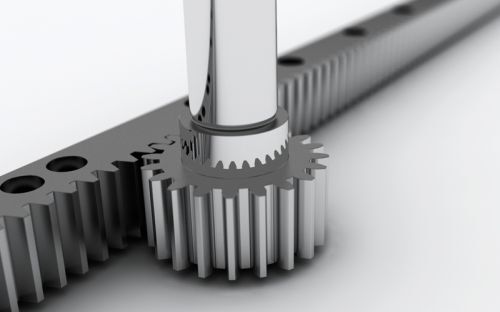
Although rack and pinion is a very well-established technology with a longstanding design, there’s a wide range of differences among products. When implementing a rack and pinion component for your application, you must account for many factors before making your selection. Examples include size, quality number, materials used, the types of gears, contact ratio and pitch, just to name a few. This blog post will provide an overview of the different factors to consider when choosing your rack and pinion system. We’ll also explain why it pays to partner with a manufacturer with a broad selection of modular products to choose from.
Rack and Pinion Selection: Best Practices
In order to select the best rack and pinion drive, ask yourself the following questions about your application:
- Will your rack and pinion drive the load in a horizontal or vertical axis?
- How much is the mass of the load in kilograms?
- What is the required tangential force to move the load?
- What is the linear speed requirement in meters per second?
- What is the acceleration rate of the mass from point A to point B in meters per second2?
- Will the application involve any external forces, such as the cutting force of a machine tool, that must be added to the tangential force?
- What is the coefficient of friction? This allows calculation of the friction force.
Also, calculate the sum of the inertial forces (M*A) + external forces, F + friction forces (Newton). This equals the tangential force, which is used to size the rack and pinion.
Be sure to have an understanding of basic rack and pinion concepts. Here are a few concepts to remember using examples from our comprehensive product line:
- Straight versus helical racks. Straight racks have teeth parallel to the axis of pinion rotation, and less than two pinion teeth make contact with the rack (contact ratio). Helical racks have teeth that are at an angle to the axis of pinion rotation. They have a contact ratio of >2, which means that two pinion teeth are always in contact with the rack, giving them greater stiffness. They also make less noise at high speeds (>1 meter per second), but create an axial load that requires support from bearings and the machine frame.
- Length. At Redex, we offer standard rack lengths up to two meters. Unlike ball screws, which are limited to three meters, our rack and pinion drives are modular. Any required axis length can be achieved by mounting the racks end to end.
- Diametrical pitch (P) versus Module (M). In the imperial system, P is the number of teeth/pitch diameter, with units 1/inch. In the metric system, Module M is used and defined as M = pitch diameter in millimeters/number of teeth. The two values are related by P = 25.4/M. Redex specializes in metric module racks.
- Quality number. The quality number defines a group of tolerances for all aspects of gear teeth quality including runout, pitch error, profile error, etc. Redex parts are made in accordance with German DIN standards where lower numbers indicate higher quality. We also compare these numbers to the American Gear Manufacturers Association’s (AGMA) quality numbers per standard 2000-A88 where higher numbers indicate higher quality. For example, induction hardened racks with ground teeth are quality DIN 6 corresponding to AGMA 12 and they provide exceptional strength and machine tool-level quality.
- Speed. Ball screw linear speed is limited to just 1 meter per second, but a rack can achieve linear speeds up to five meters per second and higher depending on lubrication.
- Customization. Not only can you achieve the length you need using modular rack and pinion drives, we can customize your metric rack with different materials, larger modules and special machining.
To learn more about these requirements and obtain answers to your questions, be sure to visit our FAQ page.
The Right Rack and Pinion Manufacturer Makes a Difference
When it’s time to choose a rack and pinion for your linear axis drive, it pays to work with a manufacturer that offers a wide range of products and customization capabilities. Our systems are available with a standard range of straight (spur), circumferential pitch and helical racks and pinions. The modular rack and pinion drives come in modules of one to 10 millimeters (diametral pitch, P, from 25.4 to 2.54 inches-1) with lengths up to three meters, allowing loads from one to 100,000 pounds to be moved at speeds up to 1,000 feet per second (five meters per second). Six quality levels are available, up to hardened and ground (DIN 5, AGMA 13). This wide range of products, plus customization capabilities, make Redex well-positioned to meet any size, power, speed, quality level and price requirement.
For more information about Redex rack and pinion drives and systems, visit our product page.
